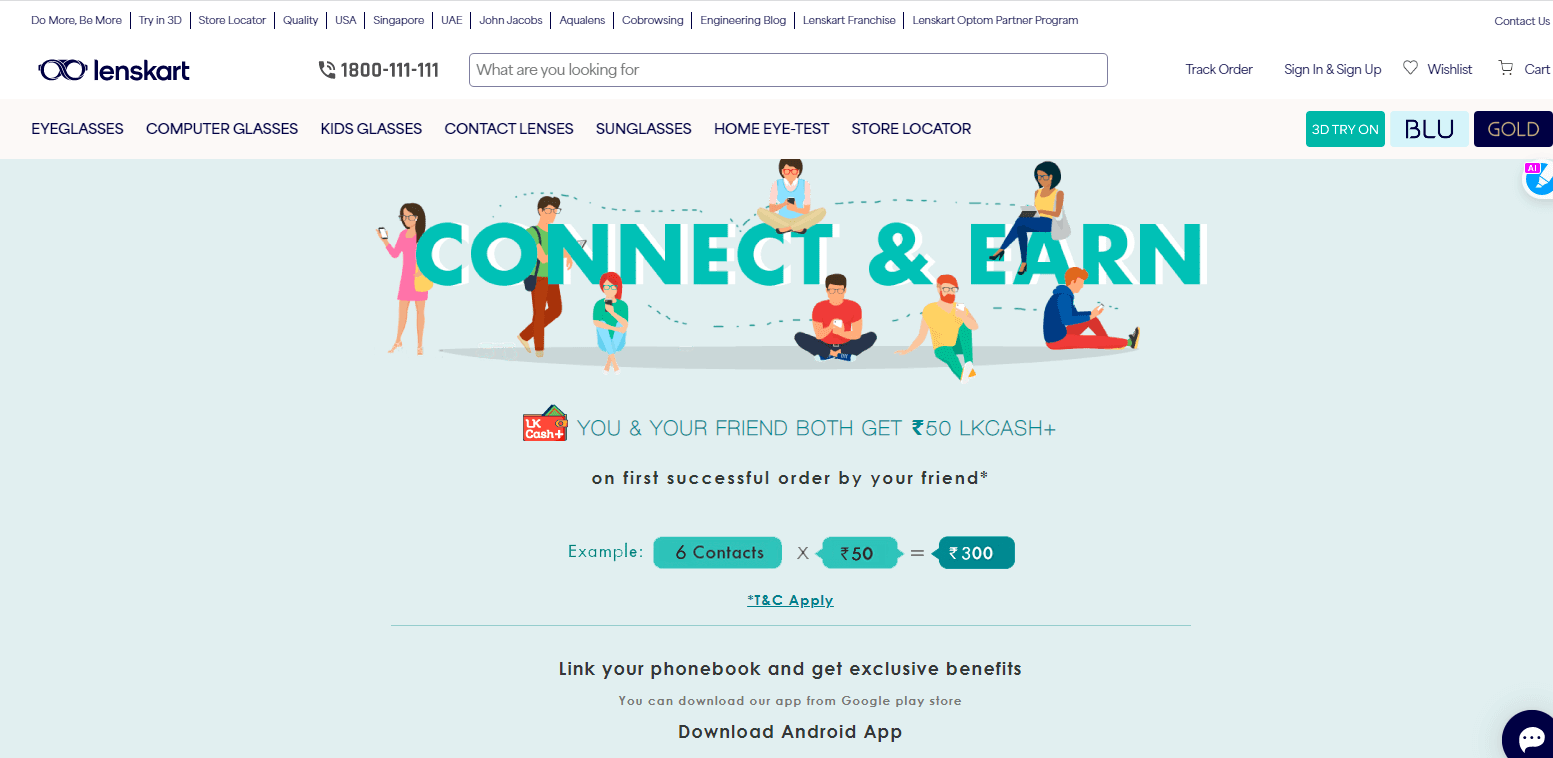Lenskart is one of the leading brands that is ruling the market of eyewear accessories. But its journey was not that easy! Why? You may wonder. Because it was launched during the time when online shopping was accessible to only a handful of Indians. Also, people lacked trust in online products and services.
Fortunately, the scenario changed and the evolution of the Internet gave new rays of hope to online brands like Lenskart. It became one of the greatest eyewear brands in India. But how? Through its business model. So, here we are presenting the “Lenskart Business Model” with its numerous revenue sources & marketing strategies.

Stay tuned!
Lenskart: A Brief Overview
Lenskart is an Indian e-commerce company that specializes in eyewear, including eyeglasses, sunglasses, and contact lenses. It is one of the D2C brands that went offline too to expand its services. It has a unique business model that aims to provide eyewear of high quality at affordable prices. Before jumping into the details of the Lenskart Business Model, let’s have a brief overview of the company-
| Company’s Name | Lenskart |
| Type of Industry | Prescription Eyewear Opticians |
| Founded in | 2010 |
| Founders | Peyush Bansal (CEO), Amit Chaudhari, Sumeet Kapahi |
| Headquarters | Faridabad (Haryana, India) |
| Operating Space | D2C (Direct to Customer) |
| Market Valuation (FY22) | Rs.36,742 crore |
| Revenue (FY22) | Rs.1,503 crore |
| Expenses (FY22) | Rs.1,726 crore |
| Net Profit/Loss (FY22) | Loss of Rs.102 crore |
| Competitors | Eyemyeye, Specsmakers, Titan Eyeplus, Amazon, Lensbazaar |
Working Strategy: How Does Lenskart Work?
Lenskart business model is based on eliminating the middlemen to sell high-quality eyewear to millions of Indians at affordable prices. Lenskart’s working strategy revolves around providing a seamless and convenient shopping experience to its customers. This D2C brand accomplishes its tasks through a combination of online and offline channels. Below are some key elements of Lenskart’s working strategy-
1. Inventory-based Model

Lenskart’s business model starts with designing and manufacturing most of the products themselves. This means it is based on an inventory-based model. Eventually, it helps them maintain quality control. And reduce the price of the products compared to what they would have been if they were outsourcing the manufacturing processes. Its manufacturing facility is located in New Delhi. As per the reports, it manufactures more than 3 lakh glasses per month. Lenskart provides the following types of products-
- Contact lenses
- Eyeglasses
- Sunglasses
- Frames
- Reading Glasses
- Computer Glasses
- Kids Glasses
- Polarized Glasses
- Other vision care products
2. “Home try-on” Feature
This model allows you (customers) to select up to five frames and have them delivered to your home for a trial period at no cost. The execute delivers the trial frames and waits till you try the frames and select the perfect one. The “Home try-on” feature is the key highlight of Lenskart Business model. The customers can try the frames and decide which one suits them best before making a purchase, which gives them greater control and confidence in their purchase decision.
3. Franchise Model (Omni channel Presence)

In addition to its online presence, Lenskart also has a network of physical stores across India. These stores are based on the franchise model. Here, customers can try on eyewear and get their eyes tested by qualified optometrists. The company has grown rapidly since its establishment. Thus, Lenskart has both an online and offline presence. This omnichannel presence allows Lenskart to reach customers who prefer to shop online or offline. This feature provides a seamless shopping experience across channels. As of April 2023, Lenskart has over 2,000 stores in India.
To own a Lenskart franchise, you need to invest Rs.35-40 lakh. In the Lenskart franchise, you can expect a profit margin of 13-35% with more than 30% ROI (Return on Investment).
4. Strong Supply Chain & Logistics
Lenskart has a strong supply chain and logistics network. The broad network allows it to deliver eyewear products quickly and efficiently. The company has its own manufacturing unit and works closely with its suppliers to ensure timely delivery of products.
5. Steps
Do you know Lenskart is famous for its “Try Before You Buy” model? Because you get free trials before buying it. Being a customer, you need to follow the given steps to find the perfect lens of your choice.
Step 1: Choose the frames
First of all, you need to select the frames of your choice and need. You can select a maximum of five frames. Then add them into the cart for “Home trial.”
Step 2: Payment
You need to pay a verification charge of Rs.1 for this service. You can go for digital payment options like Paytm, PhonePe, UPI, etc.
Step 3: Home Trial
Lenskart’s delivery executive delivers those frames to your doorstep. You can try them and check whether they are the perfect fit for you or not. The delivery executive waits till you make a final choice.
Step 4: Confirmation
Once you finalize the model, fill up the form and place that order online.
Step 5: Final Delivery of the product
Finally, post-confirmation, Lenskart delivers the package (selected frame) in the next 2-3 days.
6. Investment in technology
Lenskart uses technology to enhance its customer experience and optimize its operations. The company has developed a mobile app that allows customers to virtually try on eyewear using their phone’s camera and has also introduced AI-powered chatbots to assist customers with their queries. Also, it has a strong focus on innovation. It is constantly introducing new products and services to enhance its customer experience. The company has introduced products like Blue cut lenses, 3D printed eyewear, Smart glasses, etc. It also has a subscription feature called “Lenskart Gold Membership.” We will discuss it in detail in the section “Revenue Sources.”
Revenue Sources: How does Lenskart Earn money?

In the fiscal year 2022, Lenskart earned revenue of Rs.1,503 crores through its diverse revenue sources. Some of the major revenue sources of Lenskart are-
1. Sale of Products
The sale of eyewear products was the main source of income for Lenskart in FY22. It contributed around 94.3% of the total operating revenue. The company makes money with different price points of eyewear to cater to the diverse needs of its customers. The remaining revenue came from subscription fees and other sources.
2. Subscription Feature
Lenskart has a famous subscription feature “Lenskart Gold Membership.” It is a loyalty plan with which you can get exclusive offers for a whole year. These offers also include the privilege of “Buy 1 Get 1,” free eye checkups, etc. The total membership cost for one year is Rs.708 including the GST. This acts as a crucial source of revenue apart from the sale of products.
3. Home-eye Checkups

Lenskart provides free home eye checkups to its customers, which can lead to increased sales of eyewear products. Additionally, the company charges a fee for eye checkups for customers who are not looking to purchase eyewear products. These checkups cost a minimum of Rs.99. Thus, it provides an additional revenue stream.
4. Physical Stores
Lenskart also earns revenue from its physical stores across India, where customers can try on eyewear and get their eyes tested by qualified optometrists. The company charges a fee for eye checkups at its physical stores.
Thus, with numerous revenue sources, Lenskart has successfully gained a strong foothold in the market of eyewear.
Marketing Strategies

Lenskart uses various marketing strategies to reach and engage with its target audience. Some of the major ones are-
1. Television Advertisements
Lenskart heavily relies on interesting and entertaining television advertisements. The TV ads not only gain the attention of the viewers but also encourages them to try Lenskart glasses. Television commercials have played a crucial role in bringing awareness regarding the brand in the market.
2. Celebrity endorsements
Lenskart has roped in several celebrities, including Katrina Kaif, Bhuvan Bam, and others, to endorse its products and services. These endorsements help to increase brand visibility and credibility and attract new customers.
3. Partnerships and collaborations
Lenskart has partnered with several brands and organizations to reach a wider audience and provide additional value to its customers. Some of the key partners of Lenskart are-
4. Referral program
Lenskart has a referral program that incentivizes existing customers to refer their friends and family to the platform. Its popular referral program is “Connect & Earn.” Here you will get Rs.50 if your referred contact makes a purchase on Lenskart. However, terms and conditions apply to these offers. This program helps to increase customer acquisition and loyalty and provides an additional revenue stream for the company.
Challenges Faced by Lenskart
Lenskart faces the following competition in the market-
1. Offline Competition
Traditional brick-and-mortar eyewear stores pose competition, requiring Lenskart to find ways to attract customers away from the convenience of physical stores.
2. Quality Perception
Overcoming the perception that online eyewear might compromise on quality compared to in-person purchases was a significant hurdle. The inability to physically try on glasses online led to concerns about fit and style, which Lenskart had to address with virtual try-on technology.
3. Customer Education
Educating customers about the importance of regular eye check-ups, correct prescriptions, and understanding different lens options was essential.
4. Returns & Refunds
Managing returns and refunds for eyewear with prescription lenses can be complex due to customization, requiring clear policies and procedures.
5. Market Saturation
As the online eyewear market grew, Lenskart faced increased competition from new entrants, making differentiation and customer retention more challenging.
6. Competitive Pricing & Fashion Trends
Balancing competitive pricing and offering discounts without affecting profitability was a constant challenge. Staying up-to-date with changing fashion trends and offering a variety of styles that appeal to a diverse customer base required continuous effort.
Lenskart has tackled these challenges through a combination of innovative technology, customer-centric strategies, and effective communication to maintain its position as a leading player in the online eyewear industry.
Conclusion
The company’s focus on customer satisfaction and convenience has helped it establish a strong presence in the Indian eyewear market. With increasing demands, Lenskart is looking for building an automated factory in Bhiwadi (Rajasthan). It will have to capacity to produce 5 crore glasses per month. Thus, Lenskart Business Model has played a main role to achieve the heights of success!


I bought lenskart goggles, very comfortable
Glad to know that!